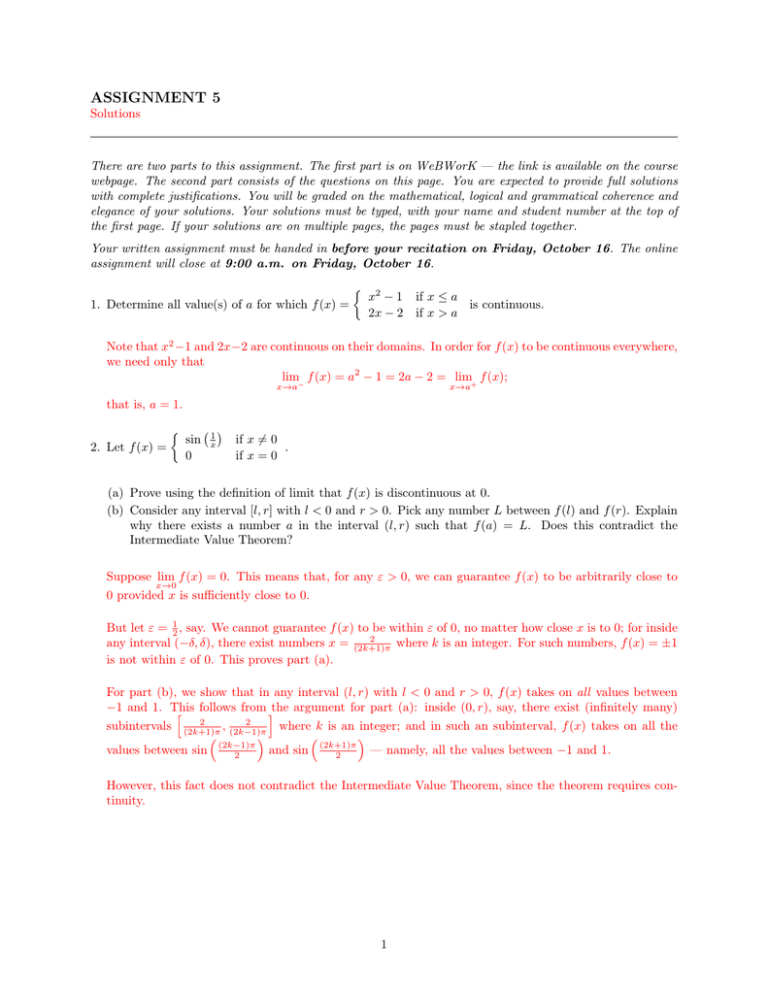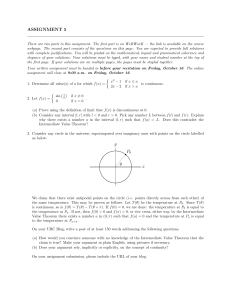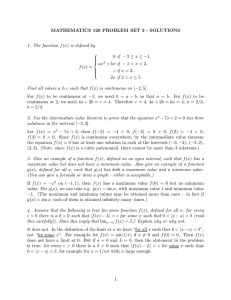ASSIGNMENT 5
advertisement

ASSIGNMENT 5 Solutions There are two parts to this assignment. The first part is on WeBWorK — the link is available on the course webpage. The second part consists of the questions on this page. You are expected to provide full solutions with complete justifications. You will be graded on the mathematical, logical and grammatical coherence and elegance of your solutions. Your solutions must be typed, with your name and student number at the top of the first page. If your solutions are on multiple pages, the pages must be stapled together. Your written assignment must be handed in before your recitation on Friday, October 16. The online assignment will close at 9:00 a.m. on Friday, October 16. 1. Determine all value(s) of a for which f (x) = x2 − 1 if x ≤ a is continuous. 2x − 2 if x > a Note that x2 −1 and 2x−2 are continuous on their domains. In order for f (x) to be continuous everywhere, we need only that lim− f (x) = a2 − 1 = 2a − 2 = lim+ f (x); x→a x→a that is, a = 1. 2. Let f (x) = sin 0 1 x if x 6= 0 . if x = 0 (a) Prove using the definition of limit that f (x) is discontinuous at 0. (b) Consider any interval [l, r] with l < 0 and r > 0. Pick any number L between f (l) and f (r). Explain why there exists a number a in the interval (l, r) such that f (a) = L. Does this contradict the Intermediate Value Theorem? Suppose lim f (x) = 0. This means that, for any ε > 0, we can guarantee f (x) to be arbitrarily close to x→0 0 provided x is sufficiently close to 0. But let ε = 21 , say. We cannot guarantee f (x) to be within ε of 0, no matter how close x is to 0; for inside 2 any interval (−δ, δ), there exist numbers x = (2k+1)π where k is an integer. For such numbers, f (x) = ±1 is not within ε of 0. This proves part (a). For part (b), we show that in any interval (l, r) with l < 0 and r > 0, f (x) takes on all values between −1 and 1. This h follows from ithe argument for part (a): inside (0, r), say, there exist (infinitely many) subintervals 2 2 (2k+1)π , (2k−1)π values between sin (2k−1)π 2 where k is an integer; and in such an subinterval, f (x) takes on all the and sin (2k+1)π — namely, all the values between −1 and 1. 2 However, this fact does not contradict the Intermediate Value Theorem, since the theorem requires continuity. 1 3. Consider any circle in the universe, superimposed over imaginary axes with points on the circle labelled as below. We claim that there exist antipodal points on the circle (i.e. points directly across from each other) of the same temperature. This may be proven as follows. Let T (θ) be the temperature at Pθ . Since T (θ) is continuous, so is f (θ) = T (θ) − T (θ + π). If f (0) = 0, we are done: the temperature at P0 is equal to the temperature at Pπ . If not, then f (0) < 0 and f (π) > 0, or vice versa; either way, by the Intermediate Value Theorem there exists a number a in (0, π) such that f (a) = 0 and the temperature at Pa is equal to the temperature at Pa+π . On your UBC Blog, write a post of at least 150 words addressing the following questions. (a) How would you convince someone with no knowledge of the Intermediate Value Theorem that the claim is true? Make your argument in plain English, using pictures if necessary. (b) Does your argument rely, implicitly or explicitly, on the concept of continuity? On your assignment submission, please include the URL of your blog. 2






